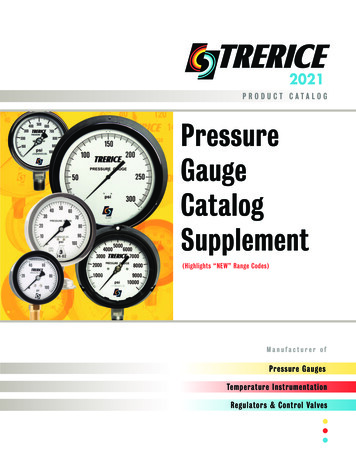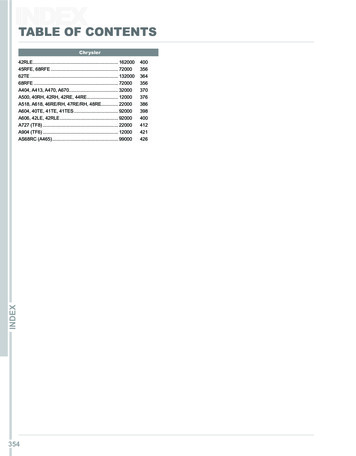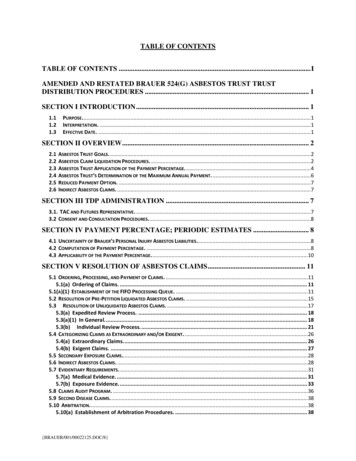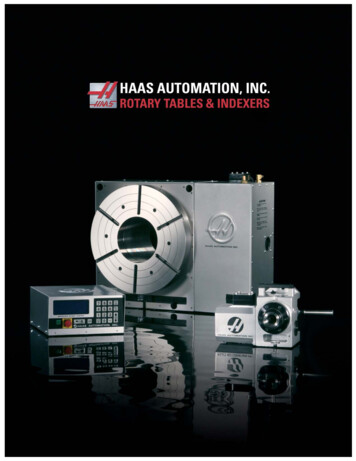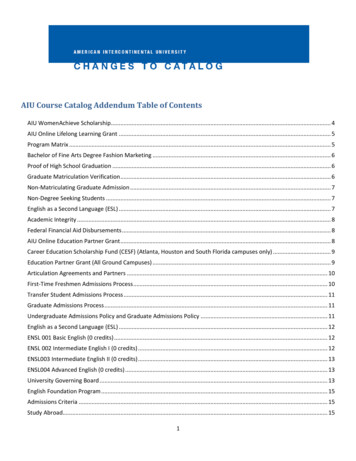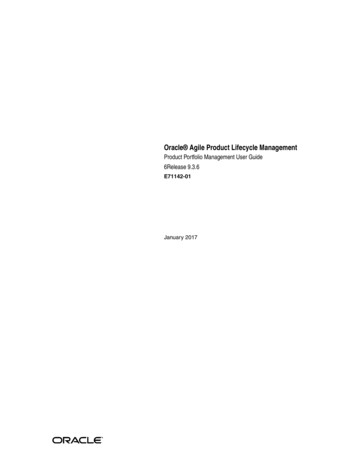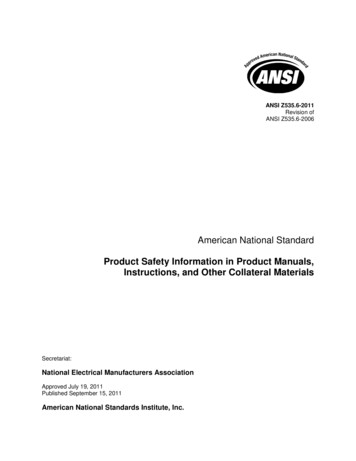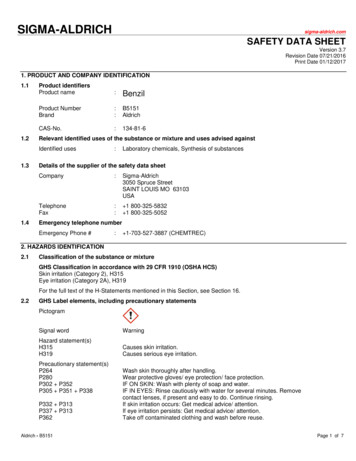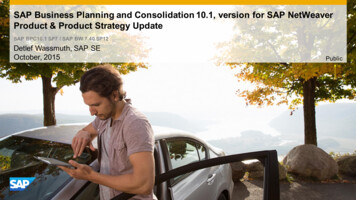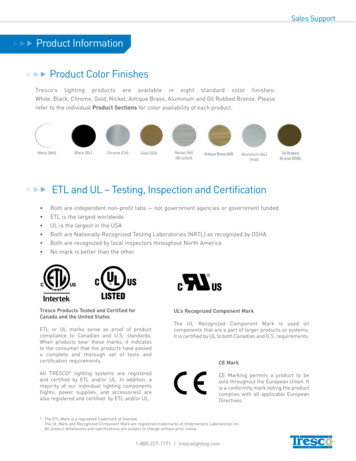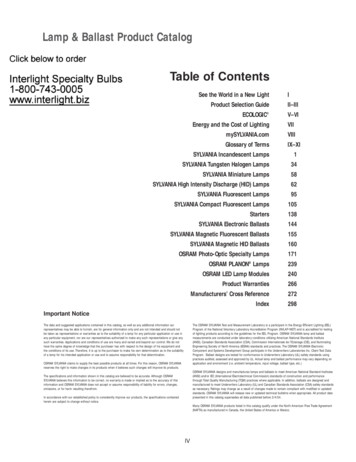
Transcription
Lamp & Ballast Product CatalogTable of ContentsSee the World in a New LightIProduct Selection GuideII–III V–VIECOLOGICEnergy and the Cost of LightingVIImySYLVANIA.comVIIIGlossary of TermsIX–XISYLVANIA Incandescent Lamps1SYLVANIA Tungsten Halogen Lamps34SYLVANIA Miniature Lamps58SYLVANIA High Intensity Discharge (HID) Lamps62SYLVANIA Fluorescent Lamps95SYLVANIA Compact Fluorescent Lamps105Starters138SYLVANIA Electronic Ballasts144SYLVANIA Magnetic Fluorescent Ballasts155SYLVANIA Magnetic HID Ballasts160OSRAM Photo-Optic Specialty Lamps171 OSRAM PLANON Lamps239OSRAM LED Lamp Modules240Product Warranties266Manufacturers’ Cross Reference272Index298Important NoticeThe data and suggested applications contained in this catalog, as well as any additional information ourrepresentatives may be able to furnish, are for general information only and are not intended and should notbe taken as representations or warranties as to the suitability of a lamp for any particular application or use inany particular equipment, nor are our representatives authorized to make any such representations or give anysuch warranties. Applications and conditions of use are many and varied and beyond our control. We do nothave the same degree of knowledge that the purchaser has with respect to the design of his equipment andthe conditions of its use. Therefore, it is up to the purchaser to make his own determination as to the suitabilityof a lamp for his intended application or use and to assume responsibility for that determination.The OSRAM SYLVANIA Test and Measurement Laboratory is a participant in the Energy Efficient Lighting (EEL)Program of the National Voluntary Laboratory Accreditation Program (NVLAP-NIST) and is accredited for testingof lighting products according to the guidelines for the EEL Program. OSRAM SYLVANIA lamp and ballastmeasurements are conducted under laboratory conditions utilizing American National Standards Institute(ANSI), Canadian Standards Association (CSA), Commission Internationale de l’Eclairage (CIE), and IlluminatingEngineering Society of North America (IESNA) standards and practices. The OSRAM SYLVANIA ElectronicComponent and Systems Development Group participate in the Underwriters Laboratories Inc. Client Test DataProgram. Ballast designs are tested for conformance to Underwriters Laboratory (UL) safety standards usingpractices audited, assessed and approved by UL. Actual lamp and ballast performance may vary depending onapplication and environment (i.e. ambient temperature, input voltage, ballast type, etc.)OSRAM SYLVANIA claims to supply the best possible products at all times. For this reason, OSRAM SYLVANIAreserves the right to make changes in its products when it believes such changes will improve its products.OSRAM SYLVANIA designs and manufactures lamps and ballasts to meet American National Standard Institutes(ANSI) and/or IEC (International Electrotechnical Commission) standards of construction and performancethrough Total Quality Manufacturing (TQM) practices where applicable. In addition, ballasts are designed andmanufactured to meet Underwriters Laboratory (UL) and Canadian Standards Association (CSA) safety standardsas necessary. Ratings may change as a result of changes made to remain compliant with modified or updatedstandards. OSRAM SYLVANIA will release new or updated technical bulletins when appropriate. All product datapresented in this catalog supersedes all data published before 2/4/04.The specifications and information shown in this catalog are believed to be accurate. Although OSRAMSYLVANIA believes this information to be correct, no warranty is made or implied as to the accuracy of thisinformation and OSRAM SYLVANIA does not accept or assume responsibility of liability for errors, changes,omissions, or for harm resulting therefrom.In accordance with our established policy to consistently improve our products, the specifications containedherein are subject to change without notice.Many OSRAM SYLVANIA products listed in this catalog qualify under the North American Free Trade Agreement(NAFTA) as manufactured in Canada, the United States of America or Mexico.IV
OSRAM SYLVANIA’s innovative program of environmental responsibility—ECOLOGIC —was designed as a thorough approach to reducing theenvironmental impact of our processes, packaging and products.Today, ECOLOGIC is even more comprehensive, having evolved toinclude other elements of sustainability, such as source reductionand reuse, recycling and recyclability, and environmental managementsystems in product manufacturing.Sustainability in ActionEnergyFor our customers, installing energy-efficient lighting is one of the most effective, sustainabledesign strategies available today. Reduced energy usage means reduced utility emissions, whichmeans reduced environmental impact.At OSRAM SYLVANIA we have long been the energy-efficient product innovators. We were first withhigh performance T8 fluorescent lamps in North America. In 1981 we introduced the SYLVANIAOCTRON family of fluorescent lamps, ushering in a new era of lighting efficiency. For years wehave offered our customers optimal design and energy performance with The SYSTEM SOLUTION concept-- our inventive offering of energy-efficient SYLVANIA lamps and ballasts. By bringing lampand ballast development under one roof, we have been able to design SYLVANIA lighting systemsthat optimize energy savings without sacrificing other elements of performance.V
SYLVANIA ECO ProductsSource Reduction and ReuseOSRAM SYLVANIA pioneered the use of lead-free solders and welded lamp bases, as well as the use of lead-free glass in high intensitydischarge (HID) light sources. We have eliminated lead solder in themajority of SYLVANIA general purpose incandescent A-19, B-10, andglobe-shaped lamp products; most of our halogen lamp types arelead-free. We also offer the only lead-free, mercury-free high-pressure sodium lamp on the market, and have won acclaim from thelighting community for this research and development breakthrough.ECOLOGIC is more than just a single productsolution to today’s environmental issues;SYLVANIA ECO products comprise an entirefamily of lighting options guided by our uniquelife-cycle approach to product development.Since 1990, OSRAM SYLVANIA has joined the lamp industry inreducing mercury content in total U.S. lamp shipments by 67%,and in four-foot fluorescent lamps by an average of 80%. Our NewHampshire plants have instituted innovative programs to reclaimunused metal halide and high-pressure sodium arc tubes.This approach places strict environmental focuson all stages of lamp life, driving our continualsearch for improvement—and we have moreOver the past 15 years, OSRAM SYLVANIA’s packaging departmenthas aggressively pursued source reduction strategies, reducing thethickness and combined weight of both primary and secondary packaging for all of our products. Through advanced computer softwareand scientific methods, we have optimized packaging systems fromprimary through secondary to unit load, saving packaging materials,pallets, fuel, transportation, and warehouse space, without compromising shipping performance. These benefits extend through theentire supply chain. Our lamp components and highest volume packaging raw materials are typically shipped in re-usable containers, andall packaging is printed using organic soy-based (non-solvent) inks.ECO products than any other lamp manufacturerin North America.SYLVANIA ECO products are engineered to pass theFederal TCLP test for hazardous waste determination: Tested in accordance with EPA SW846 Prepared for testing in accordance withNEMA LL series standardsRecycling PhilosophyECO products also feature some or all of the following:OSRAM SYLVANIA publicly promotes recycling as the preferred methodof lamp disposal. As a matter of policy, our own warehouse and manufacturing locations recycle broken lamps. When our SYLVANIA LightingServices personnel complete lighting retrofits or maintenance calls, weship all spent mercury-containing lamps to a bona-fide lamp recyclerfor processing. Furthermore, we encourage distributors and retailersof our SYLVANIA products to offer lamp-recycling programs to theircustomers, thereby reducing the burden on the solid waste stream. Reduction or elimination of toxic materials Lamp bases using lead-free solders Welded lamp bases Lead-free glass in HID products Precision dosing systems ensuring consistentlow mercury content Performance equal to or better than standard,non-ECO productsRecycled and Recyclable Materials ECO-friendly packaging, using recycled materialsand soy-based inksWe use only recycled mercury in our energy-efficient fluorescentand HID products. 95% of SYLVANIA packaging comes from renewable resources, and 90% of high volume packaging is made frompost-consumer or post-industrial recycled materials. Virtually all of ourlamp packaging is recyclable. Permanent ECO identifier printed on lampor stamped into metal base Long life with sustained performance High efficacyOSRAM SYLVANIA recommends that all mercury-containing lampsthat are discarded by non-residential users should be recycled,regardless of any exemptions that users may have under their stateor local laws. Information about lamp recycling, and individual staterules for lamp disposal, can be found at www.lamprecycle.org.VI
Energy and the Cost of LightingInefficient lighting systems waste energy and money. In a typical commercialapplication, lighting can represent 30-50 percent of operating costs. An investment in energy efficient lighting systems from OSRAM SYLVANIA can reducethese costs and offer an excellent return on investment.Calculating CostsAnnual Energy Cost Savings WorksheetLighting represents 30 to 50 percent of operating costs in a typicalinstallation. Electricity alone represents 86 percent of those costs,on average, with 11 percent going to maintenance and only 3 percent actually being spent on lighting hardware. Obviously, selectingthe most energy efficient lighting systems is the key to getting thebest possible return on your lighting investment.Use this 3-part calculation to determine the estimated annualenergy cost savings resulting from an upgrade of one lampor system type throughout a facility. This annual cost savingsfigure may be compared with the cost of the upgrade todetermine simple payback and rate of return (ROR).NOTE: For fluorescent systems, substitute “lamp” with“system” or “fixture” so that ballast watts are included.Minimize Operating Costs1.Understanding the basic equations of lighting economics makes iteasy to see that long-term operating costs are the most importantcost factor, not the initial investment in lamps, ballasts or otherhardware. In both retrofits and new installations, it is the overallreductions in energy costs which pay back the initial investmentand provide substantial long-term returns.Compute the totalpower (kilowatts,kW) saved byupgrading olderlamps to energysaving SYLVANIAreplacementsOriginalLamp WattageReplacementLamp Wattage–Watts Savedper Lamp# of Lampsto ReplaceX 125DULUX LampsOffer SignificantSavings 100EnergyCost 100 NetSavings 762. 75Over the long service life ofDULUX compact fluorescentlamps, their low energy usageprovides a substantial returnon investment compared toincandescent lamps with anequivalent light output (savingsbased on 0.10 per kWh). 50EnergyCost 23 25Lamp Cost 16.50*(10 X 1.65)Lamp Cost 17.50*100W IncandescentDULUX EL 23W* approximate retail costCompute the totalenergy (kilowatthours, kWh) savedannually byperforming thisupgrade1000Total KilowattsSavedHours of Useper DayDays of Useper WeekWeeks of Useper Year XXX3.SYLVANIA OCTRON QUICKTRONIC System Solutions Provide Substantial SavingsCompute thetotal energy costsavings per year 200Total WattsSavedTotal KilowattsSavedTotal kWhSaved per YearYour Energy Costper kWh (typically 0.10) XTotal Energy CostSavings per Year 150Initial Costof Lighting UpgradeSimple Payback 100Total Energy CostSavings per Year 50Years 0YEAR:- 50012345Payback Period6789Rate of Return(ROR)10Net Savings %Compared with a conventional F40T12 SS 4-lamp magnetic system, a SYLVANIA OCTRONFO32T8/QUICKTRONIC 32 LP System Solution can return more than 200 in energy savingsover a 10-year period (savings based on 0.10 per kWh operated 4000 hours/year).VII100Simple Payback
We invite you to visit us online at www.mySYLVANIA.com/register to learn about the manylighting solutions available for today’s modern lighting applications. Good lighting is morethan just pleasing to the eye. It’s a smart, cost-effective way to improve both safety andproductivity in the workplace. With SYLVANIA products, you can actually cut your lightingcosts and save on lamp replacement and labor costs while improving lighting quality. Weunderstand the needs of the commercial marketplace and have developed a wide variety oflighting solutions specifically designed for you. Your portal features: Your Resource Solution Site Energy Savings Calculator Electronic Catalog Product Specification Industry Links ECOLOGIC Certification Program Training Energy Saver Certification Program Transaction Details for PartnersVIII
Product Catalog Glossary of TermsAmpere A unit expressing the rate of flow ofelectric current.ANSI (American National StandardsInstitute) The organization that developsvoluntary guidelines and produces performancestandards for the electrical and other industries.Audible Noise (Sound) All fluorescent lampballasts produce some noise. Most OSRAMSYLVANIA brand ballasts are sound rated A (upto 75% quieter than magnetic types) and areacceptable for most applications. Care shouldbe taken when mounting the ballast to reducevibration.Average Rated Life An average rating, in hours,indicating when 50% of a large group of lampshave failed, when operated at nominal lamp voltage and current; manufacturers use 3 hours perstart for fluorescent lamps and 10 hours per startfor HID lamps when performing lamp life testingprocedures; every lamp type has a unique mortality curve that depicts its average rated life. ForPhoto-Optic specialty lamps, average rated liferefers to the operating period after which on statistical average, 50% of the lamps will perform withintheir specified values.Ballast A device used with an electric dischargelamp to obtain the necessary circuit conditions(voltage, current and waveform) for starting andoperating; all fluorescent and HID light sourcesrequire a ballast for proper operation. Dimmingballasts are special ballasts which, when usedtogether with a dimmer, will vary the light output ofa lamp. OSRAM Photo-Optic discharge lamps areeither designed for AC operation (sine wave and/orsquare wave with recommended operational frequencies below 1KHz) or DC operation (currentregulated or power regulated). Please see OSRAMlamp specifications for correct ballast or electroniccontrol gear selection.Ballast Basics Ballasts have two primary functions: 1) start the lamp and 2) control operationof the lamp once it has started. High frequencyelectronic ballasts operate lamps more efficientlyand eliminate the hum and visible flicker normallyassociated with standard magnetic ballasts.Electronic ballasts also typically have better powerquality than magnetic ballasts.Ballast Efficacy Factor (BEF) Ballast factor (asa whole number) divided by input power (watts).Used to measure the level of efficiency of similarballast models. For example, the OSRAM SYLVANIA QT2X32IS which has a ballast factor of 0.90and input watts of 59 (BEF 90/59 1.53), ismore efficient than electronic ballasts with ballastfactor of 0.875 and input watts of 62 (BEF 1.41).Ballast Factor (BF) The measured ability of aparticular ballast to produce light from the lamp(s)it powers; ballast factor is derived by dividing thelumen output of a particular lamp/ballast combination by the lumen output of the same lamp(s) on areference ballast.Ballast Fusing (See Fusing.)Ballast Life OSRAM SYLVANIA ballasts aredesigned to have an average life expectancy of60,000 hours. To maximize life, ambient temperatureshould be kept as low as possible. It is also important to maintain effective dissipation of heat using thelighting fixture as a heatsink for the ballast enclosure.Ballast Losses Power consumed by aballast that dissipates as heat instead of beingconverted into light. Electronic ballasts operatemore efficiently than magnetic or hybrid ballasts. Atypical ballast loss for a standard two lamp energysaving magnetic ballast is 12 watts, where anelectronic equivalent would only be 7 watts.Ballast Types There are three types of lightingballasts: 1) Magnetic: an inefficient device thatuses a core and coil assembly transformer toperform the minimum functions required to startand operate the lamp; 2) Hybrid or “low frequencyelectronic”: essentially a magnetic ballast with afew electronic components that switch off voltageto the lamp coil once the lamp has started. A minimal increase in efficiency is obtained via moreexpensive magnetic core material and the absenceof power to the lamp coils during operation; 3) Highfrequency electronic: a ballast that operates lampsat frequencies above 20,000 Hz. Maximum efficiency is obtained through the use of electronic circuitryand optimum lamp operating characteristics.Base The lamp base mechanically holds the lampin place in the application. The lamp base directlyor indirectly (via a cable or lead-in wires) conductselectricity from the circuit to the lamp and can bedesigned to dissipate heat. Lamp bases should beoperated within specified temperature ranges.Beam Angle The angle between the two directions for which the intensity (candlepower) is 50%of the maximum intensity as measured in a planethrough the nominal beam centerline (center beamcandlepower).Beam Spread In any plane, the angle betweenthe two directions in the plane in which the candlepower is equal to a stated percent of the maximum candlepower in the beam.Black Body (Planckian radiator) An idealthermal radiator whose SPD curve is defined by itstemperature in Kelvin and whose color coordinateslie exactly on the Planckian curve.Brightness (See Luminance.)Bulb Hard, soft or quartz glass enclosure, whichcan contain a vacuum, elemental inert gas ormetal and a means of light generation (filament orelectrodes).Candela (cd) The unit of measure indicating theluminous intensity (candlepower) of a light sourcein a specific direction; any given light source willhave many different intensities, depending uponthe direction considered.Candlepower Distribution A curve that represents the variation in luminous intensity (expressedin candelas) in a plane through the light center of alamp or luminaire; each lamp or lamp/luminairecombination has a unique set of candlepower distributions that indicate how light will be spread.IXCenter Beam Candlepower (CBCP) Theintensity of light produced at the center of areflector lamp beam, expressed in candelas.Chromaticity The aspect of color that includesconsideration of its dominant wavelength and purity.Color Rendering Index (CRI) The ColorRendering Index (CRI) measures the effect a lightsource has on the perceived color of objects andsurfaces. High CRI light makes virtually all colorslook natural and vibrant. Low CRI causes somecolors to appear washed out or even to take on acompletely different hue.Color Temperature (CT) Color temperature,which is measured in Kelvin, indicates whether alamp has a warm, midrange or cool color appearance. “Warm” light sources have a low color temperature (2000-3000K) and feature more light inthe red/orange/yellow range. Light with a highercolor temperature ( 5000K) features more blue lightand is referred to as “cool.”Compact Fluorescent Lamps Compactfluorescent lamps employ small diameter tubes thatare bent so they begin and end in a single base.This allows them to be produced in a wide varietyof configurations, greatly extending the applications for fluorescent lighting.Correlated Color Temperature (CCT)A specification of the color appearance of alamp, relating its color to that of a referencesource, black body radiator, heated to a particular temperature, measured in degrees Kelvin (K);CCT generally measures the “warmth” or “coolness” of light source appearance.Current A measure of the rate of flow ofelectricity, expressed in amperes (A).Description (See Ordering Abbreviation.)Design Amperes The approximate currentwhich the lamp will draw at design volts.Directional Lighting Illumination on the workplane or on an object predominantly from a singledirection.Double-Ended Lamps that have two basesopposite one another for series electrical connection, mechanical mounting and heat dissipation.Efficacy The rate at which a lamp is able to convert power (watts) into light (lumens), expressed inlumens per watt (LPW or lm/W). See also LPWPerformance.Electronic Control Systems (See Ballast.)EMI/RFI Electronic Ballasts contain circuits thatlimit electrical noise conducted onto the power lineor radiated through the air, otherwise referred to asEMI/RFI. OSRAM SYLVANIA ballasts comply withFCC 47 CFR Part 18, non-consumer limits forcommercial applications. Ballasts for residentialapplication must meet consumer limits. OSRAMSYLVANIA has a complete line of magnetic ballasts for residential use.
Energy A measure of work done by an electricalsystem over a given period of time, oftenexpressed in kilowatt-hours (kWh).Hertz (Hz) A unit of frequency equal to one cycleper second; see frequency.Filament A tungsten wire purposely positionedLamps in which an arc passing between two electrodes in a pressurized tube causes various metallicadditives to vaporize and release large amounts oflight. All HID lamps offer outstanding energy efficiency and service life. Metal halide lamps alsooffer good to excellent color rendering index (CRI).inside a lamp bulb, that when heated electricallygenerates radiation in the visible, infrared and ultraviolet ranges. Tungsten material is most oftenused, as it has great tensile strength, is verydurable, and can be heated very near its meltingpoint without evaporating rapidly. Lamp filamentsare offered in a variety of designs optimized forspecific applications.Fixture (See Luminaire.)Floodlight A reflector lamp with a relatively widebeam pattern. Also a luminaire consisting of lampand reflector at fixed distance providing a widefield of illumination.Fluorescent Lamp A low pressure mercuryvapor discharge light source. The electric dischargegenerates ultra-violet (UV) energy, which is absorbedby a phosphor and converted to visible light.Focal Distance The distance between a lamp(light producing element) and the focal point ofthe reflector surrounding it. Lamp alignment canbe adjusted to influence both illumination andcolor quality. Sometimes referred to as “workingdistance”.High-Intensity Discharge (HID) LampsHot Ignition The restarting of a previouslyoperating lamp shortly after turn-off. Hot ignitionis a high performance feature in many OSRAMSYLVANIA discharge lamp types.Illuminance Light arriving at a surface, expressedin lumens per unit area; 1 lumen per square footequals 1 footcandle, while 1 lumen per squaremeter equals 1 lux.Incandescent Lamp A light source usingthe principle of incandescence. When an electriccurrent passes through a filament wire (usually tungsten), the heated wire glows. Filaments of standardincandescent lamps are enclosed in a vacuum orgas-filled bulb. They provide low initial cost, goodcolor rendition and excellent optical control.Instant Start (IS) Instant start ballasts apply highFrequency The number of times per second thatan alternating current system reverses from positive to negative and back to positive, expressed incycles per second or hertz (Hz).voltage across the lamp with no preheating of thecathode. This is the most energy efficient startingmethod for fluorescent lamp ballasting. IS ballastsuse 1.5 to 2 watts less per lamp than rapid startballast. Other IS ballast benefits typically includeparallel lamp circuitry, longer remote wiring distance, easier installation due to less complicatedwiring, and capability to start lamps at 0 degrees(versus 50 degrees F for rapid start).Fusing All QUICKTRONIC ballasts containK-Factor A measurement that quantifies theFootcandle (fc) A unit of illuminance equal to1 lumen per square foot.Glow to Arc Transition In order to achieve fulleffect of non-linear equipment, such as lightingballasts, on an electrical system. Lighting systemsshould be designed so that the transformer ratingis sufficient for the ballast used (typically K-factor 4). All OSRAM SYLVANIA ballasts meet thisspecification.rated lamp life, a ballast should start a lamp sothat the time from when the lamp begins to glowto the time the lamp arc strikes should be as shortas possible. OSRAM SYLVANIA instant start ballasts typically accomplish this task within 50 msec.Lamp Manufactured light source, synonymouswith light bulb; the three broad categories ofelectric lamps are incandescent, fluorescentand high-intensity discharge.Grounding The ballast case and fixture mustLamp Current Crest Factor (LCCF) The ratioinherent electrical protection. Although there isno need to externally fuse the ballast, shouldcode or regulation require one, 3 amp slow blowfuses are recommended.always be grounded. The grounding helps assuresafety, proper lamp starting, and acceptable EMI/RFIperformance. Install ballast in accordance with national and local electric codes.of peak lamp current to the RMS (average) lampcurrent. Lamp manufacturers require a LCCF ofless than 1.70 in order to achieve full lamp life.Halogen Lamps High pressure tungstenalways consult federal, state, local and/or provincialhazardous waste disposal rules and regulations toensure proper disposal.filament lamps containing halogen gases. Thehalogen gases allow the filaments to operate athigher efficacies than incandescent lamps.Halogen lamps also provide brighter, whiter lightwith better color characteristics, longer servicelife and improved energy efficiency.Harmonic An electrical frequency that is aninteger multiple of the fundamental frequency; forexample, if 60 Hz is the fundamental frequency,then 120 Hz is the second harmonic and 180 Hzis the third harmonic. Some electronic devices,such as ballasts or power supplies, can causeharmonic distortion, directly affecting power quality.Lamp Disposal When disposing of spent lamps,Lamp Flicker Cyclic variation in output of a lightsource. High frequency electronic ballasts providea minimal level of lamp flicker. Lamp flicker frommagnetic ballasts may cause eye fatigue for somepeople.Lamp Fuse Wire or device designed to protect alamp from over-voltage or over-current conditions.OSRAM requires that all Photo-Optic lamps befused in their applications to prevent lamp overpowering. Certain lamps contain their own internalfuse. Please ensure lamps in your specific application are fused with respect to their power source.XLamp Lumen Depreciation Factor (LLDF)The multiplier to be used in illumination calculations to relate the initial rated output of lightsources to the anticipated minimum rated outputbased on the relamping program to be used.(See Lumen Depreciation and Mean Lumens.)Lens A glass or plastic element used in luminairesto change the direction and control the distributionof light rays.Light Radiant energy that is capable of producinga visual sensation.Light Center Length (LCL) The distance froma specified reference point on a lamp baseto its light center.Light Loss Factor (LLF) A factor used incalculating illuminance after a given period of timeand under given conditions. It takes into accounttemperature and voltage variations, dirt accumulation on luminaire and room surfaces, lamp depreciation, maintenance procedures and atmosphereconditions. Formerly called maintenance factor.Low Temperature Starting QUICKTRONIC instant start and programmed rapid start electronic ballasts have the capability to start fluorescentlamps at temperatures down to 0 F providing thefollowing conditions are met: 1. The ballast isoperated at rated nominal line voltage; 2. Ballastcannot be tandem/remote wired for low temperature starting applications. Please note, startingtime may increase at 0 F ambient temperatures.Enclosed fixtures are recommended as fluorescent lamps have reduced light output at coolerambient temperatures. (See specifications foreach model’s starting temperature rating.)LPW Performance Lumens Per Watt. Thenumber of lumens produced by a light source foreach watt of electrical power supplied to the lightsource. Also see Efficacy.Lumen Depreciation The decrease in lumenoutput of a light source over time; every lamp typehas a unique lumen depreciation curve (sometimescalled a lumen maintenance curve) depicting thepattern of decreasing light output. See Lamp LumenDepreciation Factor, LLDF and Mean Lumens.Lumen Maintenance (See Lumen Depreciation.)Lumens (lm) A unit of luminous flux; overall lightoutput; quantity of light, expressed in lumens. Forexample, a dinner candle provides about 12lumens and a 60-watt soft white incandescentlamp provides about 840 lumens.Luminaire A light fixture; the complete lightingunit, including lamp, reflector, ballast, socket,wiring, diffuser and housing.Luminaire Efficiency The ratio of luminous flux(lumens) emitted by a luminaire to that emitted bythe lamp or lamps used therein.Luminance (L) Light reflected in a particulardirection; the photometric quantity most closelyassociated with brightness perception, measuredin units of luminous intensity (candelas) per unitarea (square feet or square meters).
Luminance Contrast The relationship betweenthe luminances of an object and its immediatebackground.Luminance Ratio The ratio between theluminances of any two areas in the visual field.PAR Lamps Pressed aluminized reflector lamp,with the outer bulb formed from two pressed glassparts that are fu
SYLVANIA Incandescent Lamps 1 SYLVANIA Tungsten Halogen Lamps 34 . Component and Systems Development Group participate in the Underwriters Laboratories Inc. Client Test Data Program. Ballast designs are tested for conformance to Underwriters Laboratory (UL) safety standards using . “system” or
